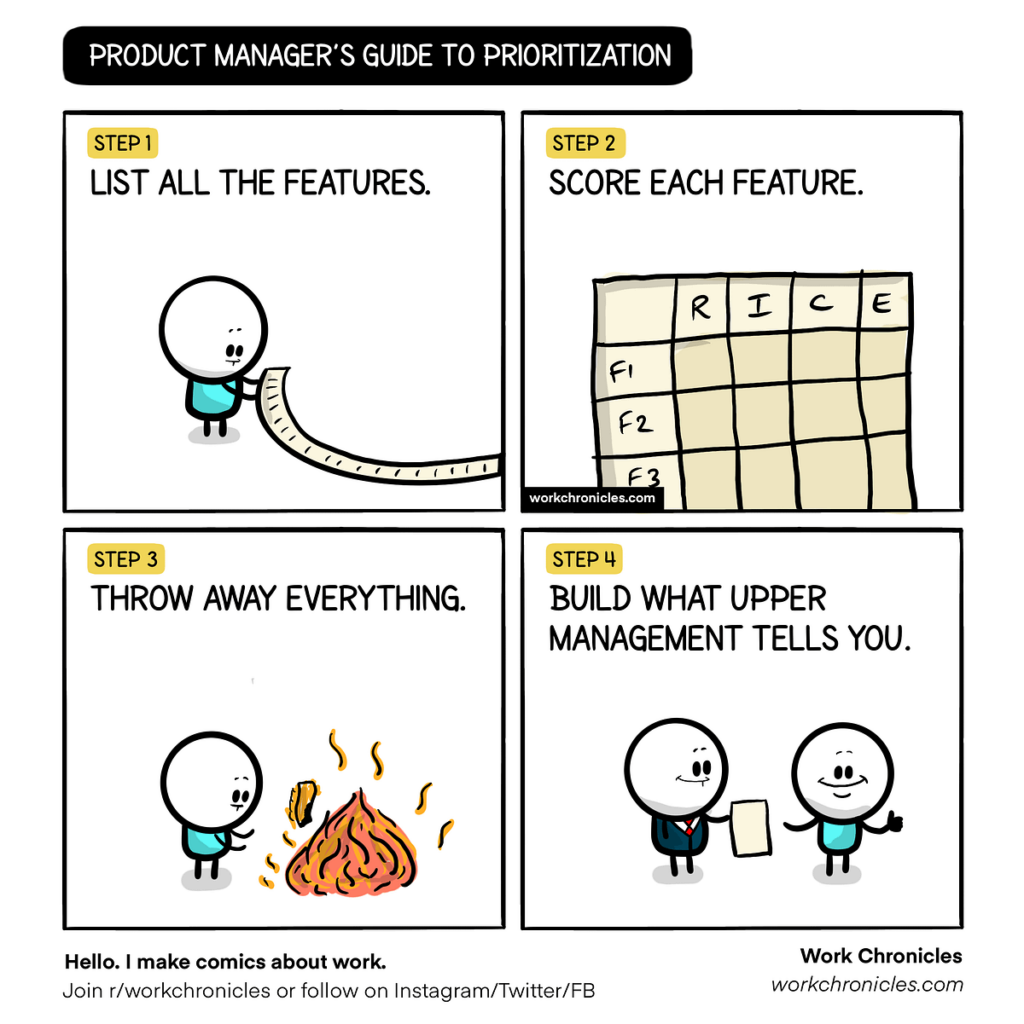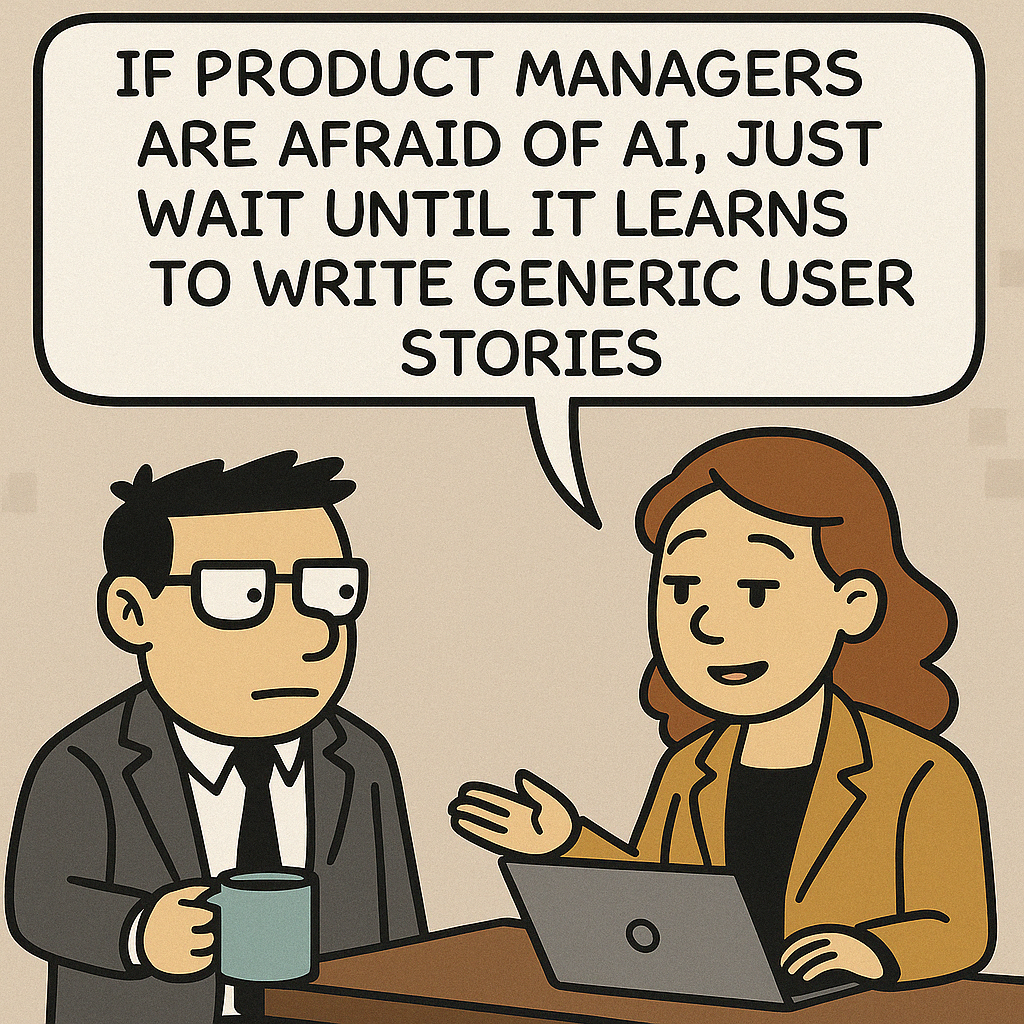
Previous Product Strategy, Roadmap and Prioritization – The GL(c) Model

AI is here. It’s at your desk, in your browser tabs, probably lurking inside your product analytics dashboard — silently judging your DAU retention curve. It doesn’t sleep, doesn’t drink your office coffee (yet), and delivers user insights before you’ve had time to copy-paste your favorite RICE template.
For product managers, this is a bit like finding out your Excel formulas have become sentient and want your job. One moment, you’re the proud owner of a well-maintained roadmap. The next? ChatGPT just rewrote it while also summarizing three meetings and suggesting a better tagline for your landing page. You’re still stuck writing a Slack message that says, “Thoughts?”
🧠 “AI isn’t replacing product managers. It’s just making them question whether they ever added value to begin with.”
— Cassie Tenner, VP of Product Existentialism @ Overthink.io
Let’s break it down. Product management is that beautiful art of taking ambiguous requests from executives, filtering conflicting opinions from stakeholders, sprinkling it all with “customer insights,” and then building something Engineering didn’t hate too much. We sit at the crossroads of vision, feasibility, and “whatever Sales promised in the last pitch deck.”
We don’t write code, we don’t design pixels, and we’re definitely not authorized to say “no” directly. But we’re responsible for the outcome of everything, anyway. Add to that Jira hygiene, roadmap storytelling, customer empathy, and a working knowledge of three prioritization frameworks that everyone ignores — and that’s just Monday.
And now, into this delicate chaos, walks AI — wearing a lab coat, brandishing statistics, and offering help with the gentle innocence of a tool that has never dealt with internal politics.
🧠 “PMs don’t do anything directly. We influence people who do. AI just does. That’s a vibe shift.”
— Rajiv “Roadmap” Sinha, Former CPO @ VisionDeck (acquired for reasons unclear)

AI is like that intern who reads every document, never asks for mentorship, and somehow delivers better work than you did with three coffees and a full team. Today’s AI can crunch your user feedback, digest your competition, and write a half-decent feature spec while you’re still trying to find the Zoom link for your retro.
Got 10,000 NPS comments? AI clusters them by sentiment. Want to draft a product brief? AI will write three — including one in haiku form if you’re feeling playful. Want to prioritize roadmap features? It’ll score them all in RICE, ICE, and SPICE, because some engineer out there was hungry while naming frameworks.
The thing is, AI doesn’t care about office politics. It doesn’t have to manage expectations. And that makes it a very useful — and slightly terrifying — co-pilot.
🧠 “I used AI to analyze our entire customer base. It told me the real pain point was… me.”
— Lana Xu, CPO @ HelloFeedback (formerly Ouchly)
“Don’t worry, we’re co-pilots,” said the AI, as it casually removed the steering wheel.
Let’s not lie — you’ve already asked yourself this: If AI can summarize meetings, write specs, prioritize features, and analyze feedback… what exactly am I here for?
But here’s the thing. AI is incredible at repetition. It’s great at scale. It’s excellent at summarizing 5,000 things you didn’t want to read. What it’s terrible at? Understanding nuance. Navigating ego. Dealing with that one stakeholder who says, “I don’t hate it… but can we make it feel more premium?”
AI doesn’t know how to say “no” in six different ways without hurting someone’s feelings. It can’t navigate organizational trauma. It doesn’t understand that a single, seemingly innocent feature request is actually a grenade lobbed into sprint planning.
So no, your job isn’t going away. But the parts of it that bored you to tears? They just might. You’re welcome.
🧠 “AI can prioritize features. But only a PM knows which ones are politically radioactive.”
— Eliot Branson, Founder @ StakeholderSoft
In a plot twist no one saw coming — especially not the AI — the rise of machines is actually making human skills more valuable. The future PM isn’t the one who can write perfect Jira tickets. It’s the one who can connect dots no tool can see, convince a team to do the impossible, and create meaning from messy input.
Empathy, storytelling, ethical judgment, and deep customer understanding? These aren’t optional soft skills anymore — they’re the job. AI can show you the problem, but it can’t explain why users are mad, or what will actually make them feel heard. AI can suggest solutions, but it can’t walk into a quarterly planning meeting and leave with stakeholders still liking each other.
The job of a PM is moving from data janitor to context-rich orchestrator. If your job used to be 80% cleaning up after everyone and 20% actual product thinking — AI just flipped that. Use it.
🧠 “AI is great at understanding language. PMs are great at understanding subtext. Good luck explaining that to a neural network.”
— Tanya Chugh, Head of Product @ PassiveAggressively.ai
“AI wrote 300 user stories last night. We’re renaming the backlog to ‘The Abyss.’”
The rise of AI doesn’t mean you need to become a data scientist — but you do need to stop calling every AI tool “just like ChatGPT, right?” Knowing how to prompt effectively, assess bias, validate outputs, and question confident nonsense is the new PM superpower.
You also need to be ethically grounded. Because the AI might help you segment your users more precisely than ever — but it won’t stop you from building a deeply creepy feature that lands you in a TechCrunch exposé titled “Startup Disrupts Privacy (Again).”
And yes, the art of asking the right question — that’s going to matter more than ever. Because in the world of AI, the smartest PM isn’t the one who has all the answers. It’s the one who knows how to get better questions answered faster.
🧠 “AI doesn’t lie. It confidently misunderstands.”
— Maya L., Principal PM @ Promptstorm
AI-savvy PMs are hot right now. And not just because they use dark mode. Salaries for AI-literate roles are trending higher across the board — with some PMs reporting 25–30% premiums over their peers. Why? Because while AI is everywhere, understanding how to use it without building Frankenstein features no one asked for? That’s still rare.
Recruiters are scanning for candidates who can not only build AI-powered products, but also challenge them. PMs who can spar with data scientists, question model outputs, and still explain it all in a pretty roadmap with stakeholder-ready metaphors. That’s gold.
🧠 “I once hired a PM who said, ‘I treat AI like I treat my cat. Useful. Unpredictable. Requires supervision.’ Instant hire.”
— Julian Cho, VP Product @ Meowlytics
Only if you think Confluence is a product strategy.
Look, AI isn’t your enemy. It’s your second brain — the one that doesn’t procrastinate, doesn’t get tired, and never rage-quits Miro. Use it. Embrace it. Make it your intern, your writing assistant, your research sidekick, your deck polisher.
But remember — it’s still you who steers the ship. You who decides what gets built, what gets killed, and what gets quietly archived while whispering “Not this quarter.”
Great PMs won’t be replaced. They’ll be elevated. As long as we stop pretending our job is just roadmaps and start owning the real stuff: decisions, direction, empathy, and alignment.
So… are you evolving, or are you waiting to be summarized?
🧠 “AI will never replace great PMs. But it will expose the mediocre ones. Fast.”
— Avi R., Product Philosopher @ Alignify (and closet meme admin)
Disclaimer : Even this post is written by AI. It took me 3 hours to guide ChatGPT to get through this tonality, humor and content to match my thought process. I would have written it myself in less than 2 hours but then I wanted to prove that I am an AI product Manager. Now, I can tell my boss that I have mastered AI and he can give me a raise and make all those AI engineers report to me. I am relevant again in the world of product management and I can now get on the stage and talk confidently about AI.